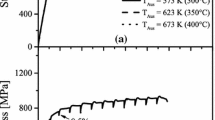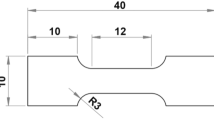Abstract
To control austenite transformation of ductile iron, thermodynamics procedures were used to calculate the Ae3, the Gr/γ (Acm), and the A1 phase boundaries of high Mn and Ni-Cu-Mn alloyed iron as a function of austenitization temperature. The results of calculation show that segregation of Mn in the intergraphite regions reduces the carbon content of austenite at the Ae3 phase boundary to the lowest value. If one ignores the effect of substitutional alloying elements on the nucleation of austenite, the austenite should first nucleate in the cell boundaries and then grow to the graphite nodules. In addition, the calculated results show that the A1 temperature is the lowest in the intercellular region of a high Mn alloy. Therefore, if the austenitization temperature is not sufficiently high, only those parts of the matrix that have the A1 phase boundary below the austenitization temperature transform to austenite, and dual formation of the α and γ phases will occur. By using the procedure introduced in this study, the volume fraction of each phase can be evaluated by calculating the A1 phase boundary as a function of intergraphite distance. In the case of Ni-Cu-Mn alloy, Ni stabilizes austenite, which lowers the Ae3 phase boundary. In this alloy, carbon content of austenite at the Ae3 phase boundary is lower near the graphite nodule and higher in the intergraphite regions. However, the variation of carbon content of austenite at the Ae3 phase boundary in the matrix of this alloy is much lower than in the high Mn alloy.
Similar content being viewed by others
References
R. Boeri and F. Weinberg: AFS Trans., 1989, vol. 93, p. 179.
M. Nili Ahmadabadi, T. Ohide, and E. Niyama: Cast Met., 1992, vol. 5 (2), p. 62.
J.M. Chou, M.H. Hon, and J.L. Lee: Mater. Sci. Eng., 1992, vol. A158, p. 241.
M. Nili Ahmadabadi and M.H. Parsa: Mater. Sci. Technol., 2001, vol. 17, no. 2, p. 162.
J.S. Kirkaldy and E.A. Baganis: Metall. Trans. A, 1978, vol. 9A, p. 495.
H.K.D.H. Bhadeshia: Department of Materials Science and Metallurgy, University of Cambridge, private communication, 1999.
R.C. Voigt: Cast Met., 1989, vol. 2 (2), p. 71.
M. Delia, M. Alaalem, and M. Grach: Int. J. Cast Met. Res., 1997, vol. 9, p. 345.
T. Wada, H. Wada, J.F. Elliott, and J. Chipman: Metall. Trans., 1972, vol. 3, p. 1657.
Metals Handbook, 8th ed., vol. 8, Metallography, Structures, and Phase Diagrams, ASM International, Metals Park, OH, 1973, pp. 400–16.
M. Nili Ahmadabadi, E. Niyama, and T. Ohide: AFS Trans., 1994, vol. 102, p. 269.
I. Ohnaka: Trans. Iron Steel Inst. Jpn., 1986, vol. 26, p. 1045.
M. Nili Ahmadabadi, T. Ohide, and E. Niyama: Cast Met., 1992, vol. 5 (2), p. 62.
D.J. Moore, T.N. Rouns, and K.H. Roundman: AFS Trans., 1986, vol. 94, p. 255.
Author information
Authors and Affiliations
Rights and permissions
About this article
Cite this article
Ahmadabadi, M.N., Shamloo, R. Control of austenitic transformation in ductile iron aided by calculation of Fe-C-Si-X phase boundaries. JPE 22, 194–198 (2001). https://doi.org/10.1361/105497101770338644
Received:
Issue Date:
DOI: https://doi.org/10.1361/105497101770338644




